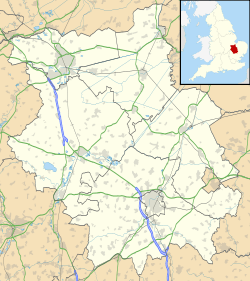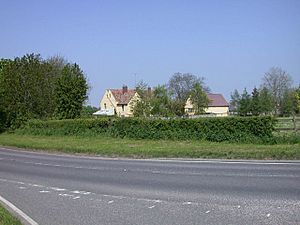Ickleton Priory facts for kids
| Monastery information | |
|---|---|
| Order | Benedictine |
| Established | 12th century |
| Disestablished | 1536 |
| Dedicated to | St Mary Magdalene |
| Diocese | Ely |
| Controlled churches | Arrington, Ickleton |
| Architecture | |
| Functional Status | defunct |
| Heritage designation | Grades II & II* |
| Designated date | 1966, 1967 |
| Site | |
| Location | Ickleton, Cambridgeshire |
| Coordinates | 52°4′15″N 0°10′15″E / 52.07083°N 0.17083°E |
| Grid reference | TL48904362 |
| Visible remains | Core of Abbey Farmhouse; 13th or 14th century barn |
| Public access | no |
| Other information | nunnery |
Ickleton Priory was a special place where Benedictine nuns lived and prayed. It was a type of priory located in Ickleton, Cambridgeshire, England. The priory started in the mid-1100s and was closed down in 1536 during a time called the Dissolution of the Monasteries. It was dedicated to Saint Mary Magdalene.
Contents
History of Ickleton Priory
The first official mention of Ickleton Priory was in a document from Pope Alexander III. This document was written between 1174 and 1181. It mentioned the priory's claim that Thomas Becket, who was then the Archbishop of Canterbury, had given the nuns money. This money was 40 shillings each year from the church in nearby Fowlmere. This gift was said to have happened around 1163.
In 1151, the land of Ickleton was given as a wedding gift. King Stephen and Queen Maud gave it to Aubrey de Vere, 1st Earl of Oxford. This was for his marriage to Euphemia.
Priory's Land and Wealth
The priory was very important in Ickleton for over 350 years. It owned the main manor (a large estate) in the parish. By 1536, this land covered about 714 acres. However, the priory did not own a huge amount of land overall. It was not a very large or rich priory.
By 1279, the priory also owned a small manor called Netherhall. This was in Arrington. In 1393, the priory gained a property in nearby Duxford.
The priory owned more land in Essex than in Cambridgeshire. This included a manor, later called Impey Hall, in Buttsbury and Stock Harward. Other lands in Cambridgeshire were in places like Ashdon, Elmington, Great Chesterford, Greshall, Littlebury and Strethall.
Churches were another way for monasteries to earn money. In 1378, Ickleton Priory only had income from two churches. These were the churches in Ickleton and Arrington. By the 1450s, the priory also received money from the church in Shingay. However, the church itself was owned by the Knights Hospitaller.
Markets and Fairs
By 1227, the prioress (the head nun) had the right to hold a weekly market in Ickleton. She could also hold an annual fair. From 1236, she was allowed to hold a market in Stock Harward.
Because the priory was not wealthy, it often did not have to pay taxes. This happened in 1256 and many times after that, including in 1402. Around 1290, the priory was valued at about £15. In 1379, a survey for the poll tax showed its income was between £26 and £66 each year.
Number of Nuns
The poll tax survey in 1379 recorded that there were nine nuns at the priory. Later records from when new prioresses were chosen show there were 11 nuns in 1444. In 1490, there were nine nuns again.
Attacks on the Priory
The priory was attacked twice during times of trouble in England. The first attack happened around 1266. This was after the Battle of Evesham during the Second Barons' War.
The second attack was on June 16, 1381. This happened during the Peasants' Revolt. Rebels attacked the priory and burned important documents. Because of this, many old records are missing. We do not have a full list of earlier prioresses or the exact number of nuns from the first 200 years.
The Priory Closes Down
In 1535, a law was passed to close down smaller religious houses in England. This was the first part of the Dissolution of the Monasteries. A survey was done to find out how much each priory was worth. Ickleton Priory was valued at about £71.
In 1536, the priory was officially closed down. Its lands and money were given to the Crown (the King). The last prioress, Joan Ashwell, was given a yearly payment of £8.
King Henry VIII had promised the priory to his doctor, Thomas Wendy. But there was a delay, so Dr. Wendy received another priory instead. In 1537, Ickleton Priory was given to a man named John Slether. Then, in 1538, Thomas Goodrich, who was the Bishop of Ely, traded some land with the King. He gave the King his manor at Hatfield, Hertfordshire in exchange for Ickleton Priory and another priory.
What Remains Today
The Victoria County History says that Abbey Farm is built on the site of the old priory. Abbey Farm is east of Duxford Road. Abbey Farmhouse is an old building, with parts of it dating back to the 1200s.
The farm also has a very old barn. This barn was built in the late 1200s or early 1300s. It was changed in the 1400s. This barn is now a special historic building called a Grade II* listed building.
However, other experts like Nikolaus Pevsner and English Heritage have a different idea. They believe Priory Farmhouse, which is a 1500s farmhouse, might be on the priory's site. This farmhouse is made of timber-framed wood and is located in Abbey Street.
The Annual Fair
Ickleton had a market and a fair that were officially allowed by King Henry III. This happened between 1222 and 1227. The priory believed an earlier king, King Stephen, had already given them permission. The market was held every Thursday. The annual fair was held on July 22, which is Saint Mary Magdalene's feast day.
The annual fair continued even after the priory was closed. In the late 1500s, it was still held in the old priory's barnyard. It still took place around Saint Mary Magdalene's feast day and lasted for five days. In the 1700s and early 1800s, it became a one-day event. People mainly traded horses and cheese there. In 1872, the farmer of Abbey Farm owned the fair. The Home Secretary, Henry Bruce, then closed Ickleton Fair under a new law called the Fairs Act 1871.



